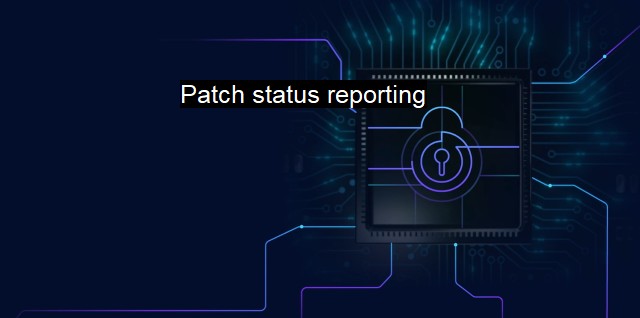What is Patch status reporting?
The Critical Role of Patch Status Reporting in Cybersecurity and Regulatory Compliance
Patch status reporting is a crucial component of cybersecurity. It involves the process of identifying, downloading, testing, deploying, and overseeing software patches with an essential focus on reviewing and submitting reports about the status of various patches.Patching refers to fixing or mending vulnerabilities within software programs, operating systems, or networks that bad actors could exploit. This concern is where patch management comes in. Patch management involves handling activities related to the application of software patches or upgrades.
In large organizations, patch management is a challenging operation, as it involves patching various software in numerous servers, workstations, and other functional elements within an enterprise. That's why the patch status reporting technology has significantly improved cybersecurity operations within organizations.
Patch status reporting is about creating an overview of the organisational and technical state of the patches. The report showcases performance metrics based on patching goals set by the organization. These metrics might include details about late patches, failed patches, patches in progress, completed patches, and outstanding patches.
An efficient patch status reporting system ensures a business retains its cybersecurity by keeping software versions up-to-date and plugging in the most recently detected security loopholes to mitigate the risk. it plays a role in complying with data protection and cybersecurity legislation, as patch status reporting can provide evidence of the measures taken to prevent malicious attacks.
To effectively function, patch status report deploys antivirus software across the digital infrastructure of an organization. Antiviruses are the first line of defense when it comes to guarding against single-headed threats like traditional viruses, trojans, worms, etc. If correct products are chosen, they could provide effective real-time reports on the status of patches including the installed and missing patches.
Patch status reporting, as the name implies, primarily maintains logs of all patching activities. Therefore, in the cybersecurity context, it's professional who facilitates patch status reporting, administration, and operation, aiming at invading attacks through proactive discovery and patching vulnerabilities.
Patch reporting systems now come embedded almost universally in Patch management software, offering system administrators a simplified snapshot of patching. This increased visibility helps pinpoint security vulnerabilities swiftly, assign threat priority ratings, and perform risk assessments promptly.
Regulating vulnerabilities can contract the potential attack surface for cybercriminals. Mediated Patch management also betters resilience against zero-day attacks, prolonging the window of exposure, and limiting exploitation risks.
Patch status reporting becomes imperative when managing an extensive network of machines spread across various divisions or geographical areas. It enables the IT team to perform regular checks, ensure the patching process is working successfully across all machines, and avoid security concerns caused due to unpatched software.
Patch status reports also allow understanding gaps in patching, regulatory requirements and refining the patching process with an audit trail traceability. Employing a clear, in-depth report can even help organizations gain valuable insights into patch performances, troubleshooting and mishap recovery capabilities, efficiently reducing downtime risks.
With the prevalence of Bring Your Own Device (BYOD) policies, remote work, and cloud computing, patch status reporting has become even more important. It allows organisations to manage software patches remotely while keeping a keen eye on patch updates and their successful implementation, strengthening corporate cybersecurity framework in the face of budding threats.
Patch status reporting has become a crucial factor in bridging the gap between cybersecurity threats and prevention steps in the field of online security. And, while patch management seems tedious, investing in comprehensive, automated software can simplify and assure the process, considerably enhancing a company’s security landscape, stabilizing sensitive data, and fostering overall digital well-being.

Patch status reporting FAQs
What is patch status reporting in the context of cybersecurity and antivirus?
Patch status reporting is a process of monitoring the updates and patches installed on the network's systems, applications, and antivirus software to ensure that they are up-to-date and have no vulnerabilities. This process helps in identifying the patches that need to be installed or updated to keep the network secure from cyber threats.Why is patch status reporting important in cybersecurity?
Patch status reporting is crucial in cybersecurity because it helps in identifying vulnerabilities and security flaws in the network's systems, applications, and antivirus software. By monitoring the patch status, security teams can keep track of the updates and patches that need to be installed or updated to protect the network from cyber threats like malware, ransomware, and phishing attacks.How often should the patch status reporting be done?
Patch status reporting should be done regularly, at least once a week, to ensure that the network's systems, applications, and antivirus software are up-to-date and have no vulnerabilities. The frequency of the reporting can also depend on the organization's security policies, the size of the network, and the level of cyber threats in the industry.What are the benefits of patch status reporting in cybersecurity?
The benefits of patch status reporting in cybersecurity includes identifying vulnerabilities and security flaws in the network's systems, applications, and antivirus software, keeping the network up-to-date and protected against cyber threats, preventing data breaches and other security incidents, reducing the risk of downtime and system failures, and maintaining compliance with security regulations and standards.| | A | | | B | | | C | | | D | | | E | | | F | | | G | | | H | | | I | | | J | | | K | | | L | | | M | |
| | N | | | O | | | P | | | Q | | | R | | | S | | | T | | | U | | | V | | | W | | | X | | | Y | | | Z | |
| | 1 | | | 2 | | | 3 | | | 4 | | | 7 | | | 8 | | |||||||